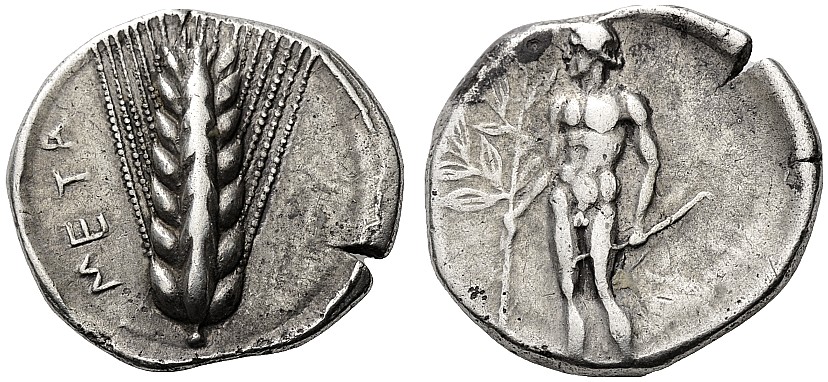Metapontum, silver, nomoi (480-400 BCE)
From SILVER
480 BCE - 400 BCE Silver 933 kg
Description
| ObverseInscription or printing placed on the obverse.: | META (Greek).Ear of barley |
| ReverseInscription or printing placed on the reverse.: | Apollo, nude, standing facing, his head to left, holding a laurel tree in his right hand and his bow in his left |
Mint and issuing power
| MintIdentifies the place of manufacture or issue of a numismatic object.: | Metapontum | Ancient regionAncient region.: | Lucania | Modern countryModern country: Italy | AuthorityIdentifies the issuing power. The authority can be "pretended" when the name or the portrait of X is on the coin but he/she was not the issuing power. It can also be "uncertain" when there is no mention of X on the coin but he/she was the issuing power according to the historical sources: |
Chronology
| FromIdentifies the initial date in a range assigned in a numismatic context. | 480 BCE | toIdentifies the final date in a range assigned in a numismatic context.. | 400 BCE | PeriodTime period of the numismatic object.: Classical 480-323 BC |
Physical description
| MetalThe physical material (usually metal) from which an object is made.: | Silver |
Median weightMedian of the weights of numismatic objects (in grams). in grams | 7.75 | DenominationTerm indicating the value of a numismatic object. Examples: tetradrachm, chalkous, denarius.: | stater |
StandardStandard.: |
Image

RQMAC 5 - Metapontum, silver, stater, 480-400 BC.jpg [1]
References
| Die study referencePublication of the study: | Noe - Johnston 19841Noe - Johnston 1984, n° 310-9, Noe 19312Noe 1931 | ||
| Coin series referenceReference to coin series study: | Sear I3Sear I, n° 398, RQEMAC4RQEMAC, n° 5, HN Italy5HN Italy, n° 1496, HGC 16HGC 1, n° 1035 | ||
Obverse dies distribution
| FrequencyFrequency of specimen in distribution. ᵖ | Number of obversesNumber of obverse dies. ᵖ (o) | % (o) | Number of coinsNumber of coins. (n) | % (n) | Die nameName(s) of the die(s). |
| 1 | 1 | 16.67 | 1 | 1.43 | 318 |
| 4 | 1 | 16.67 | 4 | 5.71 | 311 |
| 13 | 1 | 16.67 | 13 | 18.57 | 310 |
| 16 | 1 | 16.67 | 16 | 22.86 | 315 |
| 17 | 1 | 16.67 | 17 | 24.29 | 319 |
| 19 | 1 | 16.67 | 19 | 27.14 | 312 |
| Total | 6 of 6 | 100.02 | 70 of 70 | 100 |
Reverse dies distribution
no distribution is available
Quantification
| Number of obversesNumber of obverse dies. ᵖ (o) | 6 | Number of singletons (o1)The number of singleton coins. ᵖ | 1 |
| Number of reverse diesNumber of reverse dies. (r) | 11 | Number of coinsNumber of coins. (n) | 70 |
| Coins per obverse dieNumber of coins per obverse die. (n/o) | 11.67 | Coins per reverse dieNumber of coins per reverse die. (n/r) | 6.36 |
| Reverse per obverse ratioRatio of obverse dies divided by reverse dies. (r/o) | 1.83 | Percentage of singletons (o1)number of coins (n) divided by the number of singletons (o1) ᵖ | 16.67 % |
| Original number of dies (O) (Carter 1983 formula)The estimation of the number of coins according to Carter 1983 ᵖ | 6.02 | Coins struck if 20,000 as average productivity per dieCoins made if the average productivity for obverses (according to Carter) is 20,000. ᵖ | 120,400 |
| Original number of dies (O) (Esty 2011 formula)The estimation of the number of coins according to the singleton formula in Esty 2011 ᵖ (O) | 6.56 | Survival rate if 20,000 as average productivity per dieSurvival rate if average productivity is 20,000. ᵖ | 0.00058 |
| Coverage (o = % of O) (Esty 1984 formula)Esty 1984 - coverage (% of O) ᵖ (o = % of O) | 98.57% | Die productivity if survival rate 1/2,000Average productivity if survival rate is 1/2,000. ᵖ | 23,255.81 |
| Weight of silver (in kg) if 20,000 coins per die (O = Carter formula)Carter 1983 * Median weight * 20000 (*10 if gold or electrum) ᵖ | 933 kg <br /> 933 kg | Die productivity if survival rate 1/5,000Average productivity if survival rate is 1/5,000. ᵖ | 58,139.53 |
Remarks
Most likely one single workstation
References
- ^ Noe, Sydney P. - Jonhston, Ann (1984), The coinage of Metapontum. Parts 1 and 2 with additions and corrections by Ann Johnston, Numismatic Notes and Monographs 32 and 47, New York, ix, 120 p., 44 pl.
- ^ Noe, Sydney P. (1931), The coinage of Metapontum. Part 2, Numismatic Notes and Monographs 47, New York.
- ^ Sear, David R. (1978), Greek coins and their values. Vol. I, Europe, London, xl, 316 p.
- ^ Callataÿ, François de (2003), Recueil quantitatif des émissions monétaires archaïques et classiques, Numismatique Romaine, Wetteren, VII + 267 p.
- ^ Rutter N. Keith et alii (eds.) (2001), Historia Numorum Italy, London, xvi, 223 p., 43 pl.
- ^ Hoover, Oliver D. (2018), The Handbook of Greek Coinage Series, Volume 1. Handbook of Coins of Italy and Magna Graecia, Sixth to First Centuries BC., Lancaster-London, 2018, lxi, 527 pages, 23 cm